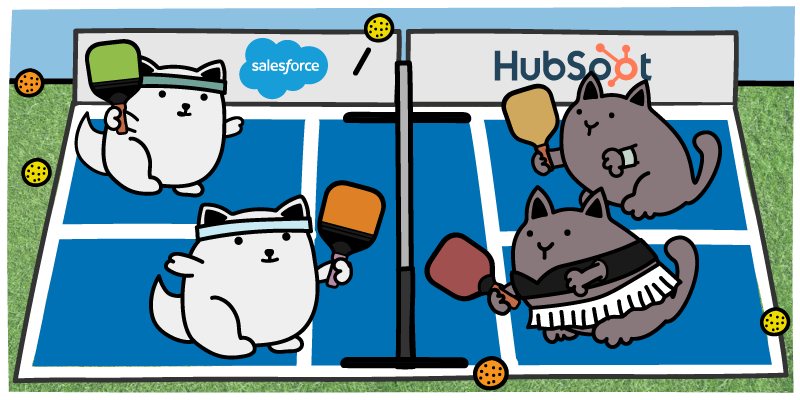In account-based marketing (ABM), the importance of maintaining child-to-parent company associations and company hierarchies cannot be overstated. These associations are critical to understanding a company's structure. They play a pivotal role in shaping how you cater your marketing and sales campaigns to them.
Today, many businesses operate with multiple CRM systems to manage their customer interactions and data. HubSpot and Salesforce are two of the most widely used platforms, offering a plethora of features to streamline sales and marketing processes. Using both of these systems can work for a while. However, as your customers’ companies grow, they hire more employees, incorporate more job titles, and acquire subsidiary organizations. Tracking these associations and engaging with accounts becomes much more difficult across multiple CRM systems.
Often, company hierarchies reflect regional set-ups. They may have different subsidiary companies that cover specific states or countries or subsidiaries based on industries served, or other categories.
Businesses may use homegrown methods for creating and updating company hierarchies and making associations in their CRMs, or they may import company hierarchy data from a third-party source, such as Zoominfo.
However, mirroring these hierarchies across multiple CRM systems like HubSpot and Salesforce is a complex task. The lack of synchronization between these systems can lead to discrepancies in data, resulting in an inaccurate representation of company associations. This can have far-reaching impacts, from miscommunication in sales and marketing efforts to skewed data analysis and reporting.
Moreover, the inability to maintain accurate hierarchies can hinder the effectiveness of ABM strategies. ABM relies heavily on understanding and targeting specific accounts, and without a clear view of a company's structure, it becomes difficult to identify and reach key stakeholders. This can lead to missed opportunities and potential revenue loss.
The process of manually recreating these hierarchies in each CRM system is not only time-consuming but also prone to errors. This labor-intensive task can divert resources away from other critical areas, affecting overall productivity and efficiency.
Let’s look more deeply at the impact of inaccurate company hierarchies in CRMs.
How Inaccurate Company Hierarchies in Your CRM Impact Your Revenue
Maintaining accurate company hierarchies in your CRM is not just a matter of administrative tidiness; it's a critical factor that can significantly impact your revenue. These hierarchies provide a comprehensive view of your business landscape, influencing every facet of ABM and beyond.
Consider a scenario where your sales team is working on a large deal with a global enterprise. This corporation has multiple subsidiaries and regional offices, each operating semi-independently but under the umbrella of the parent company. Without a clear and accurate hierarchy in your CRM, your sales team might miss out on the opportunity to engage with key stakeholders in these subsidiaries. You could leave significant revenue on the table as a result of less effective sales strategies, lost deals, and smaller deal sizes.
Moreover, company hierarchies are essential for marketing operations. They allow for more targeted and personalized marketing campaigns, as you can tailor your messaging to resonate with specific branches or levels of a company. Without an accurate hierarchy, your marketing efforts may not reach the right audience, leading to lower engagement and conversion rates.
Beyond this, if you choose to mirror the company hierarchies manually, that steals a lot of time from whomever you put in charge of handling that. The process of checking Salesforce hierarchies and re-creating them in HubSpot is extremely labor-intensive, requiring navigation through many screens to finish a single company hierarchy. That costs a lot in salary and is an easy way to introduce errors.
Accurate company hierarchies also enable more precise data analysis. They provide a clear view of a company's structure, allowing for better segmentation and more insightful reporting. Inaccurate hierarchies can lead to misinterpretation of data, which can negatively impact strategic decision-making and ultimately, your bottom line.
|
Related articles Solving Issues With Maintaining Child-Parent Company Associations in HubSpot How to Associate Child Companies to Parent Companies in HubSpot Workflows |
Why Maintaining Company Hierarchies Across Linked Salesforce and HubSpot CRMs Is Difficult
HubSpot has its own features and processes for associating companies to one another, as does Salesforce. But maintaining company hierarchies across linked CRM systems like Salesforce and HubSpot presents a unique set of challenges. These difficulties arise from the inherent differences in how these platforms structure and manage data, as well as the complexities involved in syncing information across multiple systems. The two platforms don’t natively share all relevant information, such as the IDs of associated companies in the hierarchy. As a result, when these two systems are linked, these structural differences can create inconsistencies and inaccuracies in the mirrored data.
Additionally, many companies resort to manually recreating the account hierarchies in HubSpot, a process that is both difficult and likely to run into issues. Imagine a sales rep spending hours each week manually updating the CRM to reflect changes in the company hierarchy, only to have those changes overwritten or lost due to synchronization issues. This not only wastes valuable time but also increases the risk of inaccurate data.
Creating custom-coded solutions to mirror Salesforce is another option, but this comes with its own set of challenges. Developing a custom solution requires significant investment in terms of time and resources. It also requires ongoing maintenance to ensure the solution remains effective as the CRM systems evolve. This can divert resources away from other critical projects, impacting overall productivity and efficiency.
Insycle Enables Company Hierarchy Mirroring Between HubSpot and Salesforce
Most often, companies that are in a situation of needing to mirror company hierarchies across accounts will use Salesforce as their CRM of record. This is because, compared to HubSpot, Salesforce allows for a lot more rule-building and automation functionality when it comes to building hierarchies. So companies will attempt to duplicate in HubSpot the effective hierarchy management system that they have in Salesforce.
They may have set up their own rules for building company hierarchies through Salesforce’s many automation systems, or they may be using a third-party tool that maps these hierarchies, such as Zoominfo. However, Zoominfo and other similar data providers and hierarchy tools may not always be an option due to costs.
If you’re not using Zoominfo or similar providers to mirror the hierarchies in HubSpot, many companies are left either accepting that HubSpot will not accurately store account hierarchies or will be forced to either handle it manually.
But Insycle is here to help. Let’s look at how.
Preparing Salesforce and HubSpot To Share Necessary Company Data
To prepare Salesforce and HubSpot for mirroring the company hierarchies, there are a few steps that you’ll need to take.
First, we have some settings changes to make.
Create a Custom Field in HubSpot To Hold Parent Company ID Information
Start by creating a custom field on the Companies object to hold the listed Salesforce Parent Company ID. We’ll use this ID to set the associations with Insycle.
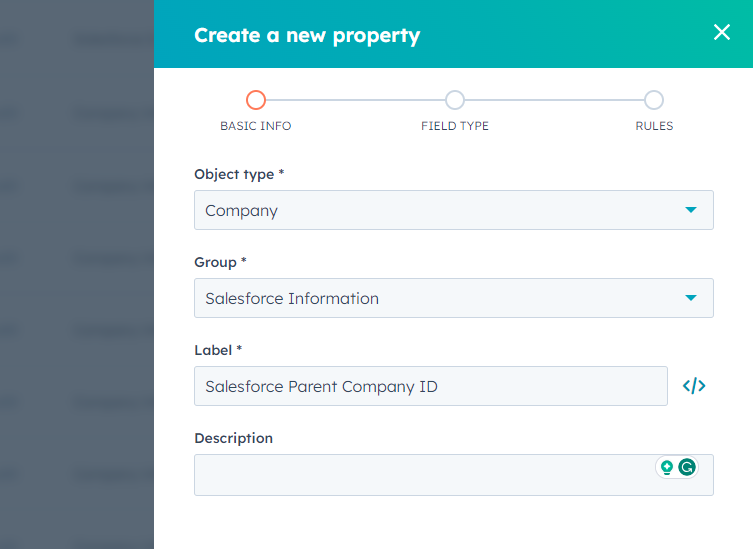
This new field must be a “dropdown select” field type.
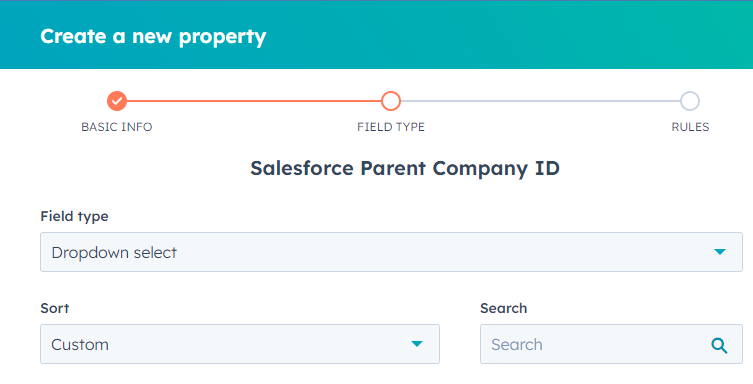
Now we have to make some HubSpot-Salesforce integration settings changes to effectively use the new field we just created.
Add a New Sync Rule and Mapping To Share Salesforce’s Parent Company ID With HubSpot
First, add a new field mapping in Salesforce integration settings. Navigate to the HubSpot-Salesforce integration page, go to the field mappings for the Company property, and set the Salesforce Parent ID field mapping to “Always use Salesforce.”
This ensures that this field will always be populated from the existing data in Salesforce.

With these settings in place, we can navigate to Insycle to create the child-parent associations in bulk, and even automate it for future use.
Creating Company Hierarchies in HubSpot, Mirroring from Salesforce
Now we will create bulk company-to-company association templates in Insycle to mirror the hierarchies from Salesforce in HubSpot.
Use the Bulk Operations Module To Create Company Hierarchies in Bulk
Go to Insycle and navigate to the Bulk Operations module, where bulk associations take place.
In Step 1, filtered for records that don’t have a parent company, and do have a listed Salesforce Parent ID. If you aren’t finding any companies with a Salesforce Parent ID, you have to sync your databases again.
This filter ensures that we are only updating company records that are part of a hierarchy in Salesforce but not in HubSpot.
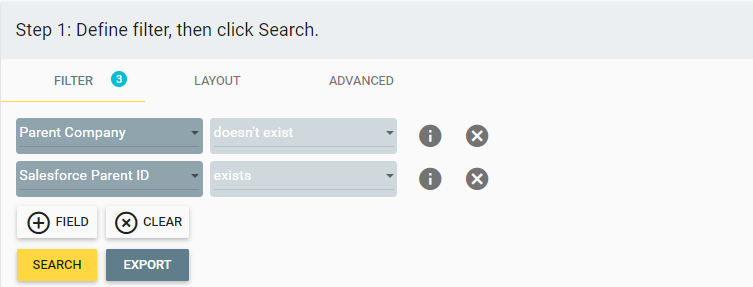
If you are using Zoominfo, the Ultimate Account ID field in Salesforce tells you the company that should be at the top of the company hierarchy, which is great for double-checking and auditing outcomes.
Next, we set our association settings in Step 2. We will use the Salesforce Parent ID we just created and the Salesforce Account ID fields to match companies with parent companies for associations.
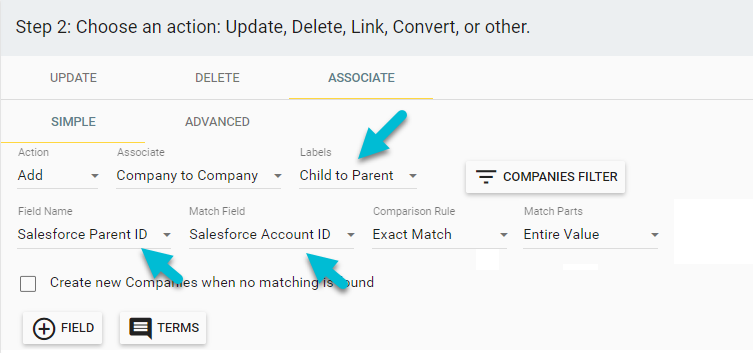
Set Up Automation To Ensure Hierarchies Are Maintained Consistently
After running your template and verifying the results, you can then automate the template to run on a set schedule. This will ensure that you're always checking Salesforce for hierarchy changes and mirroring those changes in HubSpot.
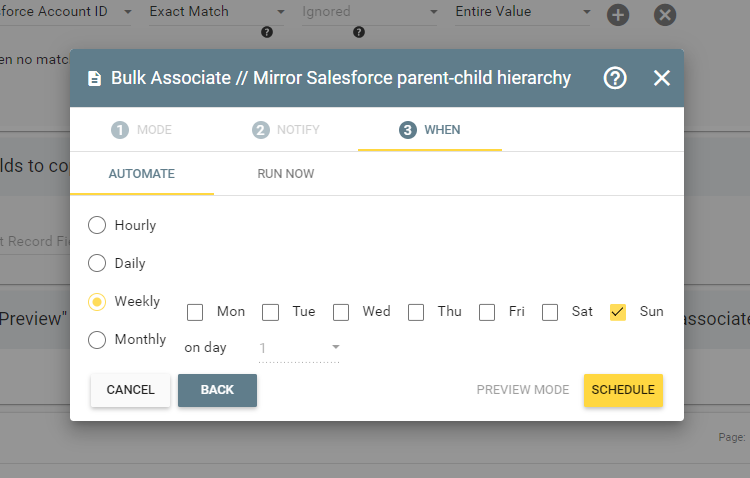
Additionally, you can inject Insycle templates directly into HubSpot workflows. That way, Insycle can check for and make the correct company hierarchy associations as soon as a new company record is created in HubSpot CRM.
Navigating CRM Hierarchy Challenges: The Insycle Solution
Insycle emerges as the perfect tool for mirroring account hierarchies across Salesforce and HubSpot. It eliminates the need for manual intervention, ensuring that your company hierarchies are accurately reflected across both CRM systems.
But Insycle is more than just a tool for mirroring account hierarchies. It's a complete customer data management platform that offers a range of features designed to streamline and enhance your CRM operations. From data cleansing and deduplication to advanced analytics and reporting, Insycle provides a comprehensive solution for all your CRM needs.
We invite you to learn more about how Insycle can help you manage your Salesforce and HubSpot data more effectively. Discover how you can leverage Insycle's powerful features to drive your ABM strategy and boost your revenue.
